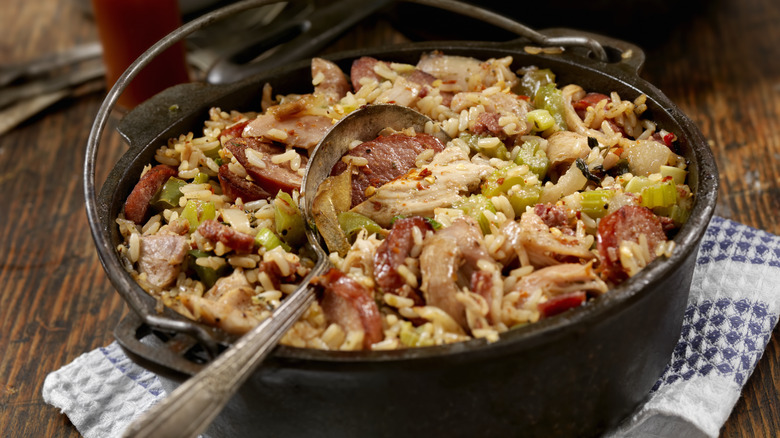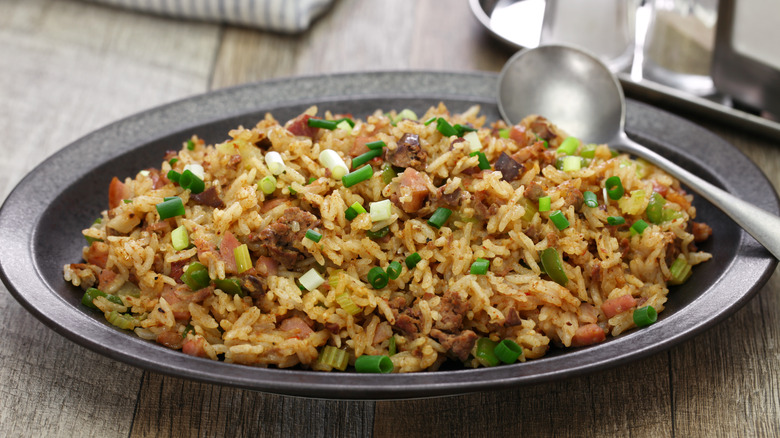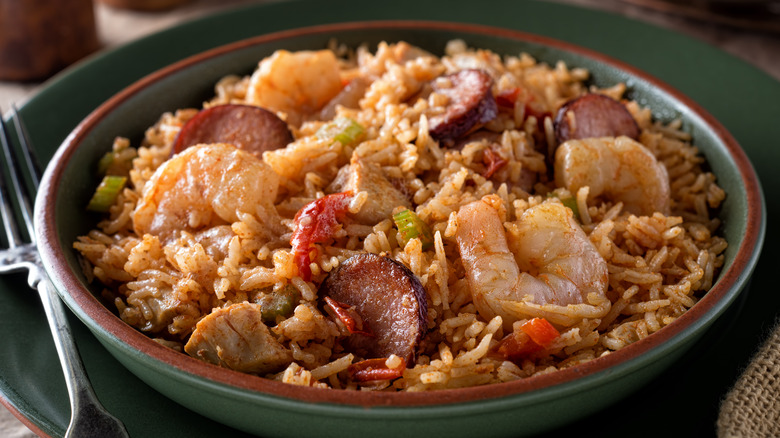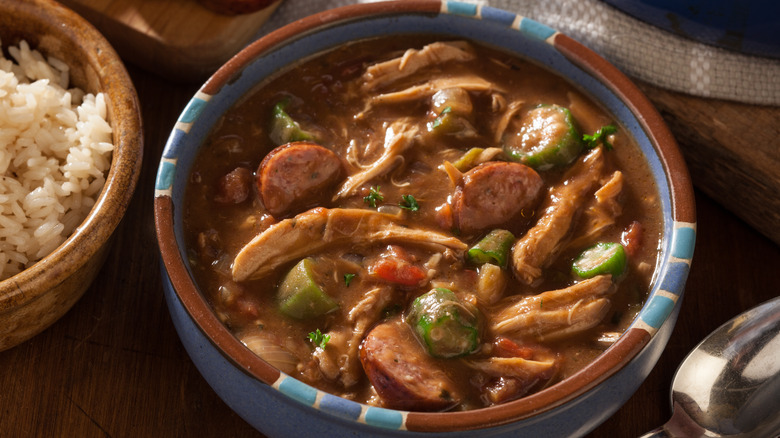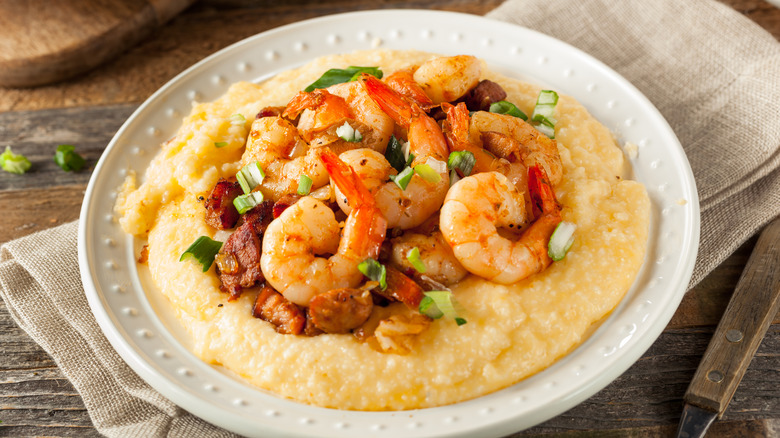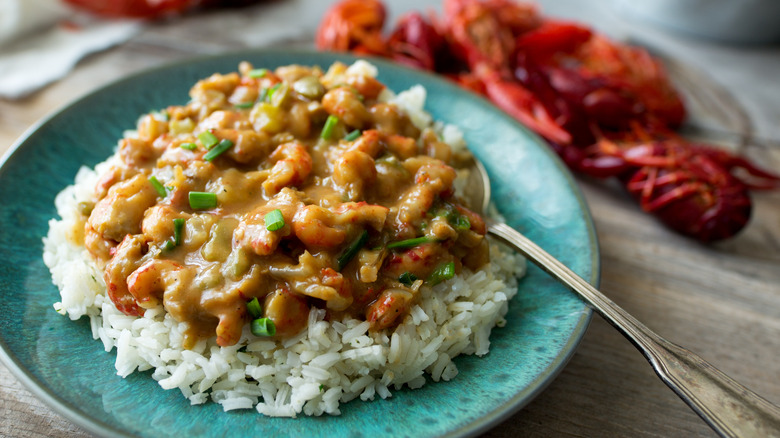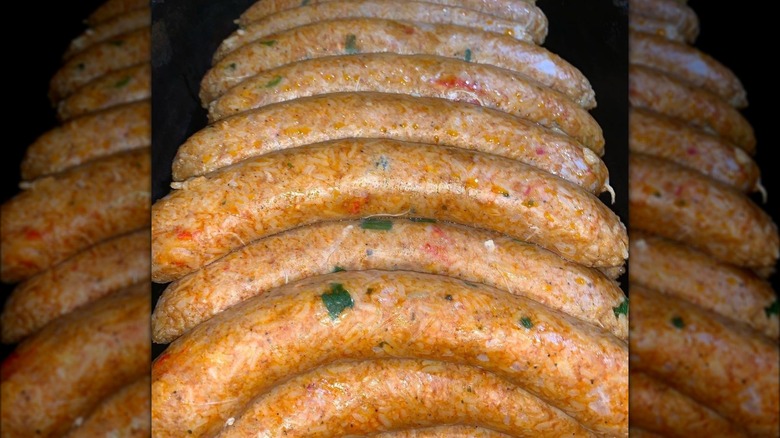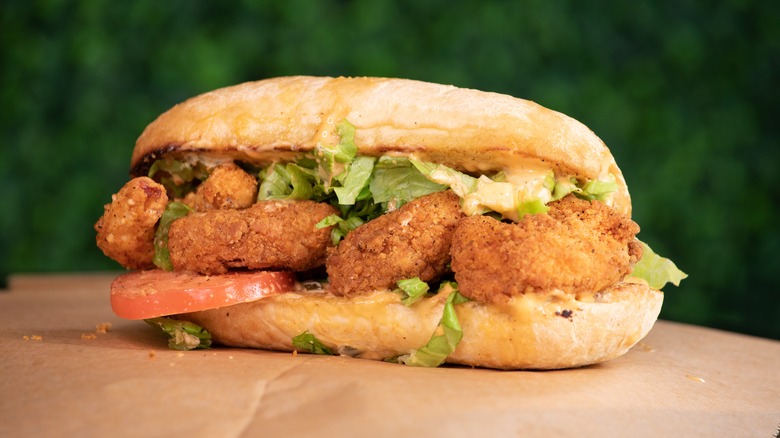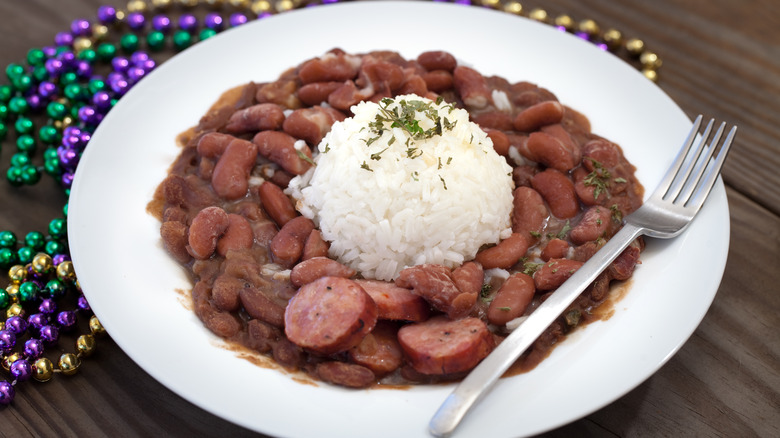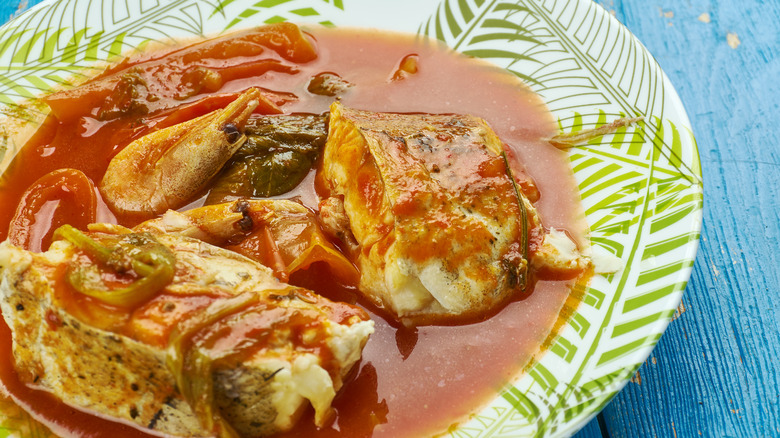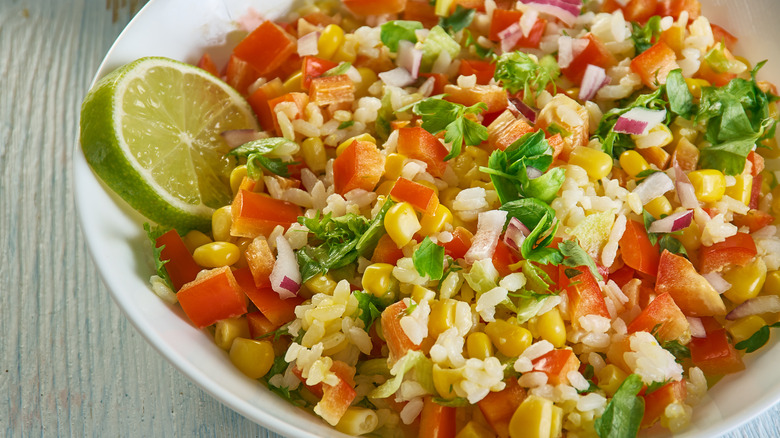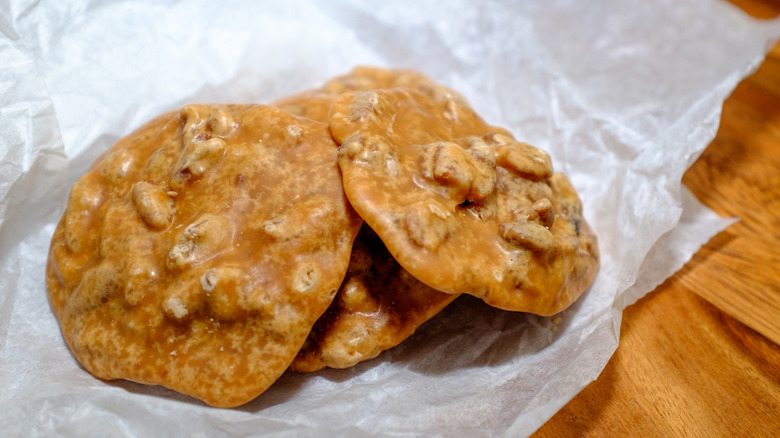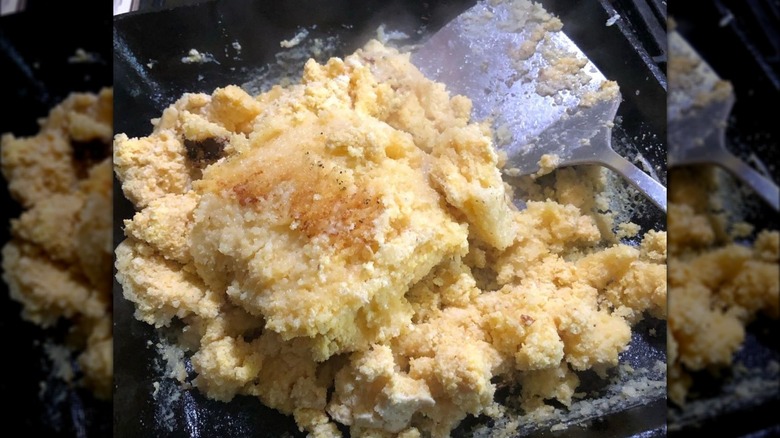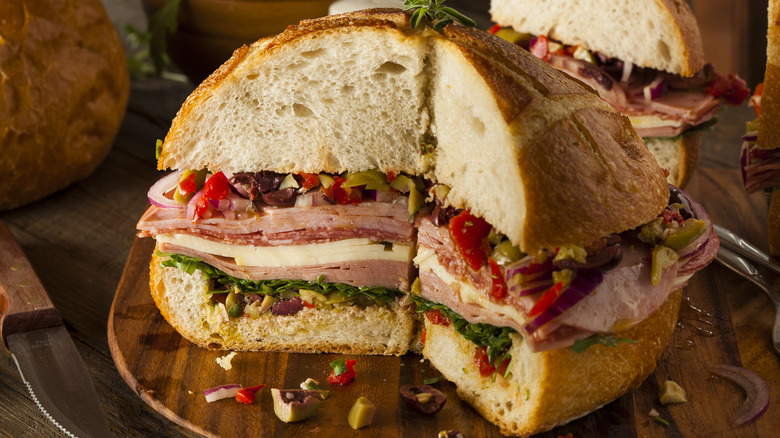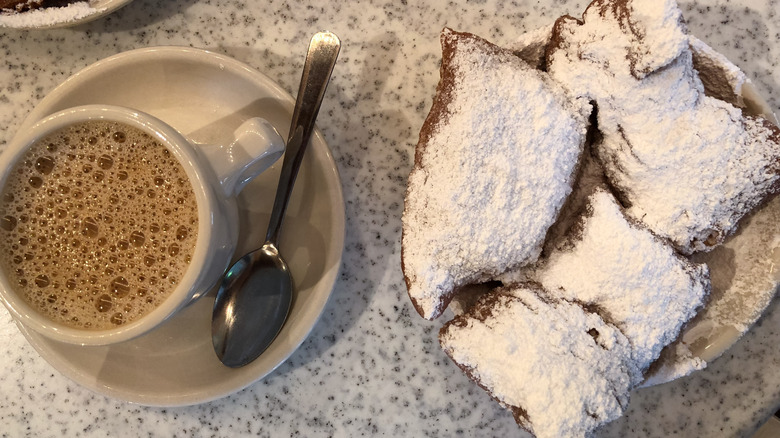14 Cajun Dishes You Need To Try At Least Once
Arguably, no cuisine is as closely tied to its region as Cajun cuisine in Louisiana. This cooking style comes from the Acadians (early French settlers in the region of Canada known as Acadie, now Nova Scotia) who migrated to Louisiana after being driven out by the British in the 1700s. After settling in Louisiana, the Acadians adapted their French recipes to what was available in their new home.
While Cajun and Creole cuisine have some similarities (and even different versions of the same dish), what sets them apart comes down to those earliest settlers. The Acadians were often poor and lived in the country, using every part of their ingredients and using only those that were easy to come by. Creole cuisine, on the other hand, was popularized by well-to-do French settlers who ended up within the city of New Orleans and could afford to incorporate more expensive local (and sometimes not so local) ingredients into their dishes.
Today, the lines between the two cuisines (and cultures) are blurred, but there are some standout Cajun dishes that everyone should try at least once. Here are a few to help you dip your toes into Cajun cuisine. Laissez les bons temps rouler!
1. Dirty rice
While calling something dirty isn't typically very appetizing, exceptions include a dirty martini and dirty rice, the latter of which is a Cajun favorite. While all Cajun cooking is rooted in French cuisine, it also incorporates other cultures from the region during the 18th and 19th centuries, including Native Americans, enslaved Africans, free people of color, Spanish immigrants, and other European influences. Dirty rice is a prime example of this rich cultural tapestry.
The dish is rooted in one created by enslaved people and tenant farmers who used the leftover scraps of meat from slaveowners' meals, chopped them up finely, and cooked them with rice. From there, it became a popular dish among the less affluent, including Cajuns, who added their twist with andouille sausage, spices, and other typical Cajun ingredients. While pork is arguably the more traditional protein in dirty rice (aside from offal, which is still used today), just about any combination of meat and vegetables can be used to cook dirty rice, so don't worry about finding the most authentic combination on the menu. Inexpensive and packed with flavor, it's a can't-miss.
2. Jambalaya
Another rice-based Cajun dish with plenty of spice and protein to go around is jambalaya. Here, we really must differentiate between Cajun and Creole versions of the dish. While both versions are undeniably delicious, Cajun jambalaya typically doesn't include tomatoes, while Creole jambalaya has a thick tomato base. Often made with chicken, andouille sausage, and plenty of spices, jambalaya is another culturally rich dish with African and Spanish influences in addition to the obvious French.
Like many Cajun dishes, the flavor base of jambalaya starts with the Holy Trinity: onions, celery, and bell peppers. From there, additions of typical Cajun spices like cayenne pepper, paprika, black pepper, and garlic build flavor for the broth in which the rice will cook. While many Louisianians may have strong opinions about their jambalaya recipe being the real deal, if authenticity is less of a concern for you, there are lots of ways to jazz up jambalaya, so don't be afraid to try unique and interesting combinations you may find on the menu.
3. Gumbo
There's a reason that Tiana from "The Princess and the Frog" started perfecting her gumbo recipe as little more than a toddler. In Louisiana, the art of making good gumbo is more than a hobby — it's a life skill. The comforting, dark roux-based stew incorporates the Holy Trinity of onions, celery, and bell peppers, as well as okra, Cajun spices, meat, and broth.
While some people may balk at the use of okra, the word "gumbo" actually comes from a West African word for the vegetable, so authentic versions should include it. The mucilage of okra also serves as a thickener for the dish. If okra is truly a non-starter, there is another traditional ingredient that can be used instead. In addition to the African influences on gumbo, the use of filé powder (dried ground sassafras leaves) as a thickener in the dish came from Native Americans.
There's no rule about what types of meat should be included in gumbo, and there are seafood versions as well as the popular chicken and sausage combination, among many others. Try several different versions of this ever-popular Cajun comfort food, typically served over rice, to see which you like best.
4. Shrimp and grits
We'll be the first to admit that the cheesy, filling dish known as shrimp and grits isn't a Louisiana original, but the Cajun version is one you have to try. While Charleston, South Carolina, likes to claim to be the dish's originator, a similar dish with ground maize and shellfish was made in Africa long before the Charleston version, and the tradition was brought along with the enslaved people to the American South, including the bayous of Louisiana. There, Cajun spices were incorporated, along with the Cajun favorite andouille sausage. While shrimp was not a cheap ingredient and, therefore, not as often used in Cajun cuisine as something like crawfish, the undeniable deliciousness of shrimp and grits gave it staying power.
Though it was initially reserved for breakfast (as that was the traditional time to eat grits), the dish is now popular any time of day and has been adapted in myriad ways, including at fine dining restaurants and even in party foods like shrimp and grits dip. Whet your appetite with the Cajun version, where the shrimp is cooked with Cajun seasonings like cayenne pepper, paprika, and garlic and the dish is often rounded out with sliced andouille sausage.
5. Crawfish boils and étouffée
Despite the popularity of shrimp in some modern-day Cajun recipes, the crustacean that takes center stage in Cajun cuisine is found in the bayous of Louisiana rather than the gulf. Crawfish were a readily accessible source of food for the Acadians who were driven to Louisiana in the 1700s. Reserved for the poor, crawfish didn't find a foothold outside of Cajun families until crawfish boils were popularized by a crawfish festival in 1960. This crowd favorite combines crawfish, potatoes, corn, Cajun seasoning, and sometimes andouille sausage, all boiled together and then poured out over a table or pan for everyone to enjoy together.
While other Louisianians, and eventually people across the country, were just getting acquainted with crawfish, Cajuns had long used it in dishes like crawfish étouffée. There are many versions of étouffée, which means "smothered" in French and is essentially a type of stew. While not all of them include crawfish, they all employ the method of smothering the main ingredient in a rich sauce, as well as building flavor with the Holy Trinity. While many étouffée recipes include tomatoes, authentic Cajun étouffée does not. Whatever method you see on a menu, étouffée and a crawfish boil are both great ways to try crawfish if you've never eaten it.
6. Boudin
Given the prominence of andouille sausage in Cajun cuisine, you'd be forgiven for thinking it's the most sought-after sausage for Cajun cooking. That honor lives instead with Cajun boudin (boo-dahn). Boudin sausage, not to be confused with San Francisco's Boudin Bakery, is found in two primary forms: boudin blanc and boudin noir. Similar to white and black pudding, the difference between boudin blanc and less common boudin noir is that the former is a mixture of pork (including offal), herbs, Cajun spices, and rice, all ground together and housed alongside onions and sometimes other vegetables in a casing made from pig intestine; the latter contains all that and the addition of pig blood.
Cajun boudin's roots are French, though versions of boudin sausage are also found in Belgium and Italy. While boudin is often cooked and eaten in its casing, another popular Cajun dish involves removing the boudin from its casing and using the filling to make fried boudin balls, which are eaten with a dipping sauce as a snack or part of a meal any time of the day, including breakfast.
7. Po' boy
Cajun food's association with the less affluent immigrants in more rural areas should make it no surprise that the po' boy (also spelled po-boy) sandwich has become a popular Cajun favorite. Named, according to some accounts, for the "poor boys" who were served the sandwich free of charge while they were on strike from their jobs as streetcar drivers, the po' boy sandwich is made from toasted French bread stuffed with meat, tomatoes, lettuce, and mayonnaise. While po' boys can be served with fried shrimp, crawfish, roast beef with gravy, boudin, or a host of other options for meat, the best po' boys, arguably, include a hefty serving of fried seafood of some kind.
For a truly Cajun take on the po' boy, try one that incorporates Cajun seasoning on the meat and utilizes a spicy remoulade in place of basic mayo. Once you've tried your first po' boy, it won't be long before you're trying it with different combinations of meat and other toppings. After all, it's completely traditional to use whatever you have on hand in Cajun cooking, so trying different combinations at a restaurant is entirely within the realm of acceptable.
8. Red beans and rice
Although some of the Cajun recipes we've highlighted are seemingly complex with many ingredients, simplicity is the name of the game for one of the most delicious Cajun dishes: red beans and rice. While this dish is mouthwatering anytime, it's often eaten on Mondays in New Orleans (served in many restaurants as a special on that day), and that's precisely because of its simplicity. According to some accounts, the dish became a staple on laundry days (traditionally Monday) when the women of the household were too busy to make an elaborate dish.
The simple dish of red beans and rice starts with the Holy Trinity of onions, celery, and bell peppers and then incorporates Cajun spices, herbs, andouille sausage, pickled pork shoulder, and red kidney beans, all simmered with stock or water until the beans are tender and the liquid has transformed into starchy, creamy goodness. We say forget about the laundry altogether and find a restaurant serving this Monday supper favorite for the perfect Cajun comfort food to start your week.
9. Catfish courtbouillon
If you've ever been to France, there's a chance you may have seen court bouillon on a restaurant menu, but that dish is very different from Cajun courtbouillon (koo-bee-yawn) in more than just its pronunciation. While both dishes are ostensibly fish stews, French court bouillon often uses expensive seafood poached in an herbaceous stock, while Cajun courtbouillon incorporates the Holy Trinity of veggies, a dark roux, Cajun spices, a bit of tomato (just a touch for traditional Cajun recipes), and whatever fish is available. One particularly popular version of the Cajun dish is catfish courtbouillon.
While the catfish takes center stage in this iteration of the dish, it's only added at the tail end of cooking, leaving it delicate and delicious. The bulk of the preparation is for the flavorful stock that serves as a poaching liquid for the catfish. Like many Cajun dishes, catfish courtbouillon is best served on a bed of white rice, which is the perfect vehicle for the luscious sauce.
10. Maque choux
While Cajun entrees get most of the attention and fanfare in foodie circles, don't sleep on the side dishes, especially maque choux. Another fabulous example of the multicultural influence on Cajun cuisine, corn-based maque choux likely takes influence from Native American dishes like succotash and combines it with the Cajun Holy Trinity of veggies (onions, bell peppers, and celery), bacon, and cream for a crunchy, sweet, peppery dish reminiscent of stewed corn salad with a kick. Other sources also note the influence of enslaved Africans and Spanish settlers on the variety and combination of ingredients.
While more familiar side dishes are often available at Cajun restaurants for the less adventurous, there's really nothing like maque choux. It's the perfect side dish alongside virtually any Cajun main course but is particularly well suited to rich, spicy offerings where the cool corn and cream can tame the spice and offer brightness. You'll often find it served alongside (or mixed with) white rice and with a dash of acid like lime or lemon juice.
11. Pecan pralines
While pecan pralines are ubiquitous in New Orleans and other parts of Louisiana today, there was a time when the only way to get them was to buy them from so-called pralinières, the women of color who sold the confection on the street as far back as the 1700s. The history of pralines is debated, with some attributing their creation to the French and others noting the history of the treat in the Caribbean.
Regardless of their origin, there's no denying pralines are delicious. While the candy-coated nuts can come in many forms, the abundant pecans in Louisiana helped solidify pecan pralines as an iconic Louisiana treat. Pecan pralines are simple and delicious with just a few ingredients — they're made primarily from pecans, sugar, butter, milk, and vanilla. All of the ingredients except for the pecans are mixed and brought to a boil before being reduced to simmer until the mixture reaches the right temperature and consistency, at which point the pecans are added and the pralines are scooped out to cool. Chewy, sweet, and melt-in-your-mouth, pecan pralines are the simple and delicious dessert that's perfect for finishing off your Cajun meal.
12. Couche couche
While some Cajun dishes have found popularity around the country (and the world), some of the most delicious Cajun offerings are little-known secrets among the locals. One such dish is couche couche, a cornmeal-based Cajun breakfast cereal that's simple and comforting. True to Cajun tradition, couche couche is made with ingredients that are commonly found in even the barest kitchen cabinets, and the dish is eaten not only at breakfast but as a snack and other light meals.
Though it's a humble meal, if you spot couche couche on a Cajun restaurant menu, you simply must give it a try. It's made with cornmeal that's poured into a pan with hot oil where it's lightly fried before being turned and mixed until it's warm and cooked through (but still a bit mushy). Traditionally, it's served with cane syrup, but some variations include milk, coffee, and preserves, as well. Somewhat like a bowl of grits or cream of wheat, the toppings and mix-ins can be sweet or savory and are largely a matter of personal preference depending on whether you're trying couche couche for breakfast, a snack, or even a light supper.
13. Cajun muffuletta
While the French, Spanish, African, and Native American influences on Cajun cuisine are commonly known, other European immigrants also contributed to the unique food style. Among those were Italian immigrants, who lent their influence to the Cajun muffuletta (also spelled muffaletta). While the muffuletta is a sandwich, it's also the name of the bread the sandwich is on. Other ingredients include olive salad, assorted Italian meats like salami, mortadella, and ham, and typically two kinds of cheese, though the exact types vary.
The muffuletta sandwich was invented in New Orleans and is still served all over the city, with slight variations that are found mostly in the olive salad that gives the sandwich its tang. In many of those variations, the olive salad also provides a spicy kick thanks to typical Cajun spices like cayenne pepper, black pepper, garlic, and paprika. Served warmed or at room temperature, it's the perfect option for walking around the French Quarter or enjoying on a restaurant patio while you people-watch.
14. Beignets and chicory coffee
Visitors to New Orleans often grab a seat at Cafe du Monde for the establishment's famous beignets and chicory coffee — and for good reason. The fluffy, donut-like pastries are deep-fried pieces of dough doused in sweet powdered sugar. The Cajun beignets in Louisiana are different from the beignets you'd find in France. French beignets are made with choux pastry, which utilizes steam to help them rise. Cajun beignets, on the other hand, use yeast to give the pastry its pillowy texture. This, like many Cajun recipes, is the result of the beignets being made from what was available.
According to local stories, the beignets in Louisiana originated when early Cajun women would pull off a portion of that day's fresh bread dough, stretch it, and deep-fry it while the rest of the dough baked. Those early beignets were served with local cane syrup, fig preserves, or sometimes plain, only later finding a partnership in powdered sugar.
While chicory coffee is not Cajun in origin, the way it is served in Louisiana finds chicory root added to French roast coffee and served au lait style. Its toasty nuttiness is the perfect companion to the Cajun beignet, making it an almost integral part of enjoying the dish.
